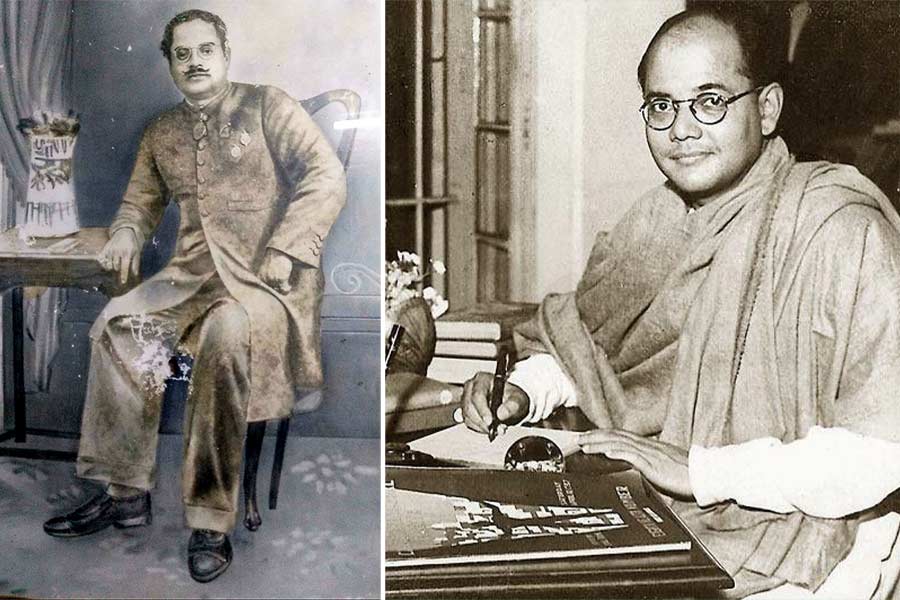An iconic man, who is larger than life to common people for nearly a century, is bound to attract many anecdotes that are half-truths, and in some cases, just baseless surmises.
Netaji Subhas Chandra Bose is one such victim of this cult of fake history — where his name is mingled in an incident with which his actual life story had nothing to do.
Out of many such fables and half-truths, his frequent visit to Swadhin Bharat Hindu Hotel, or his personal weakness for snacks from a telebhaja shop at Bidhan Sarani, flood almost every smartphone, masquerading as trivia.
It is unfortunate that some of these surmises get recorded in printed documents and websites, opening a dangerous path to becoming a so-called ‘history’ with passing time.
The worst of this was his apparent involvement of changing the traditional format of Durga Puja idols from ekchala to many chalas. Here, a myth slowly took the shape of history —insulting not only an icon like Subhash Chandra Bose, but also another globally famed Bengali — Gopeshwar Pal.
It is a genuine fact of history that it was Gopeshwar Pal, who after returning from Europe in early 1930s, brought about a revolution in Durga idol-making in one of the community pujas of north Calcutta, where, instead of placing Durga and other four votive gods and goddesses on one platform, he separated all five idols on different platforms, practically making five statues from one consolidated statue.

Gopeshwar Pal brought about a revolution in idol making
This was a near-revolution in the idol-making craft of Durga Puja in Bengal, because, before Gopeshwar, no one ever dared to make any modifications to the traditional look of a religious idol. Gopeshwar, who witnessed the artworks of human figures at many museums of Europe, thought that placing all five idols in one platform with no gap in between would not be good enough to draw the attention of spectators. So, the one and perhaps only objective of Gopeshwar Pal to break the traditional of the Durga family image was to force the spectator to give equal focus on the artistic beauty of each of the idol — because as a sculptor, his effort and creative labor are equal in each of those.
Returning to Calcutta in 1926, Pal formed a modern art studio near to his home at Kashinath Mitra Ghat Lane, and he never showed any interest in making idols for any community or family puja. He always maintained a dignified distance and wanted to cement his position as a sculptor knowing the European school of art.
However, in 1932-33, members of Kumartuli Sarbojonin, a community puja that took place near his studio, requested him to make a Durga idol for their puja. To avoid the offer, Gopeshwar demanded Rs 3,000 — an unimaginable price — as his remuneration. To his astonishment, the puja organisers agreed to pay this jaw-dropping amount! So, now he had no choice but have to accept the offer.
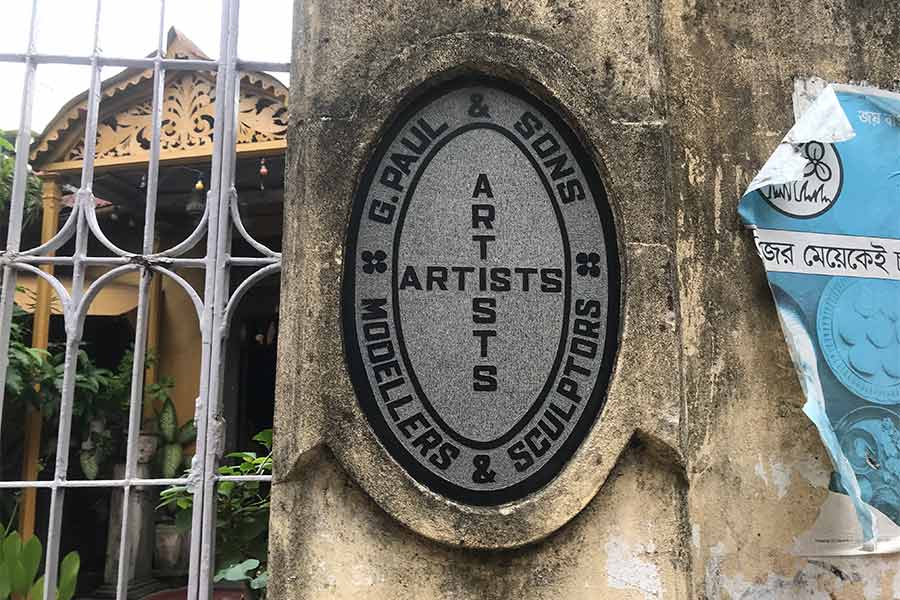
Gopeshwar Pal’s studio
Though, the actual year is not certain, but it is believed that Gopeshwar did the breaking of chala from the first year itself — because, still at his studio, there are several miniature clay models of Durga in the modern form that were done by him in the early 1930s.
However, Anita Agnihotri, in her famous book on Kumartuli, mentions that even before Gopeshwar Pal, the experiment of breaking the idol platform was conducted by a clay modeler in eastern Bengal. Though in the book, Anita does not take any name or year associated with this act. So, what Gopeshwar started working on from 1932-33 for the Kumartuli Sarbojonin puja can be called a a pioneering work of art. It was his own brainchild, and he was not ordered or requested by any public figure to do so.
So, how did Netaji Bose get involved in this?
Subhas Chandra Bose always used to believe that Durga Puja was a good bridge to connect common people with his political ideology. His association with many famous Puja committees in Calcutta is well known.
At the zenith of his political career, Bose was president of the Kumartuli Sarbojonin Durgotsav in 1938 and 1939. As one of the most popular political figures of the country, the demand to have his name associated with just about anything started from that time.
This association of Netaji as the president, and Gopeshwar Pal’s involvement in this puja as sculptor, gave fiction writers a golden opportunity to frame a history which was never in fact, history itself.
This scripted history, built up on social media, has a narrative that in the late 1930s, the puja pandal and idol of Kumartuli Sarbojonin were gutted overnight due to a devastative fire. As it was just a day before Durga Puja, president of Kumartuli Sarbojonin Subhash Chandra Bose came forward and requested Gopeshwar Pal to make a new idol overnight. The task was near-impossible, but Gopeshwar took up the challenge and instead of a typical traditional ekchala idol, he split it into five — placing each idol in a separate platform. And thus, Durga idol-making in Bengal was revolutionised and Netaji had a huge silent contribution.
Now, the question is whether such a tall claim really contains any merit to be counted as a historical fact.
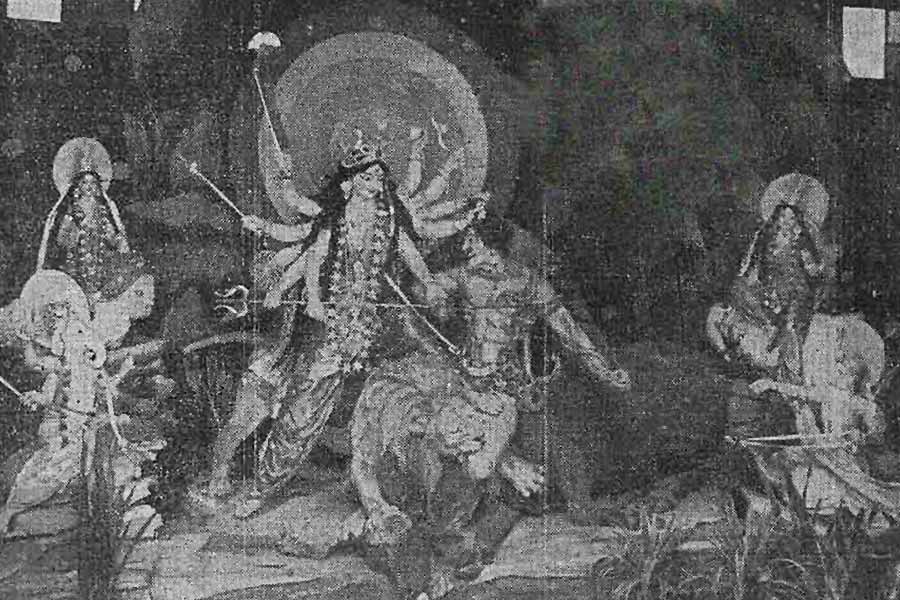
Another of Pal’s idols
Kumartuli Sarbojonin Durgotsav committee mentioned this incident in their 86th-year souvenir book. They mention the incident of the fire and the prompt act of Gopeshwar Pal, but does not say that it was done on the request of their president — Netaji Bose. The year of occurrence of this event is written as 1939.
In their official website, they clearly mention that their pandal and idol were both gutted in a fire in 1938, when Bose was their president. So, the year mentioned in the souvenir book and the website has disparity and is clearly perplexing in nature. Was there really any big fire in Calcutta in 1938 or 1939 that gutted everything? In 1938, Durga Puja was between September 29 and October 3; while in 1939, it was in between October 19 and October 22.
Independent researcher Goutam Dutt said that old archival newspaper files have no news of any major fire during the Pujas of 1938 and 1939. Rather, he pointed out that the weather in Calcutta was cloudy during these Pujas.
The laborious work of Anita Agnihotri does not mention anything on this. Rather, she says that even before Gopeshwar Pal, the breaking of the ekchala into five small chalas had started in Bengal. However, she has also written that Gopeshwar broke the traditional ekchala idol in 1937, not in 1933.
Byomkesh Pal, a descendent of Gopeshwar Pal, strongly differs from this story, and says that Gopeshwar was a man who nurtured new ideas. Gopeshwar Pal, in his own studio, made many miniature Durga model on the platform with no one else. Byomkesh Pal says a great talent like Gopeshwar had his own artistic thoughts and was not inspired by any political forces. He also made it clear that Gopeshwar did this wonder job sometime between 1935 and 1936. A research scholar named Geir Heierstad, in a paper published by Cambridge University Press, also claims the year as 1937.

Miniature clay models in Gopeshwar Pal’s workshop
So, none of the versions match with the year of occurrence as 1938 or 1939 as claimed by Kumartuli Sarbojonin puja committee. So how did the fire, Netaji Bose as president and the efforts of Gopeshwar Pal — all documented facts — come together to create a false history?
In fact, in 1940, a massive fire did indeed break out in Calcutta’s oldest community puja and exhibition fair of Baghbazar Sarbojonin — a Puja that started in 1918. Ironically, as Bose was President of two big-ticket pujas in Calcutta in 1938 and 1939, the machine of myth-making was slowly gearing up to blend both Bose and Pal.
The archival files of Amrita Bazar Patrika shows a headline on dated October 7, which reads – “Durga Images Burnt Down – Fire Accidents At Baghbazar And Chorebazar – Exhibition Totally Demolished – Midnight Outbreaks Takes North Calcutta By Surprise: Heavy Loss To Stall-holders “
In the report, it was pointed that after the fire was tamed “…another image was quickly requisitioned and artists working throughout the night finished it before the dawn”.
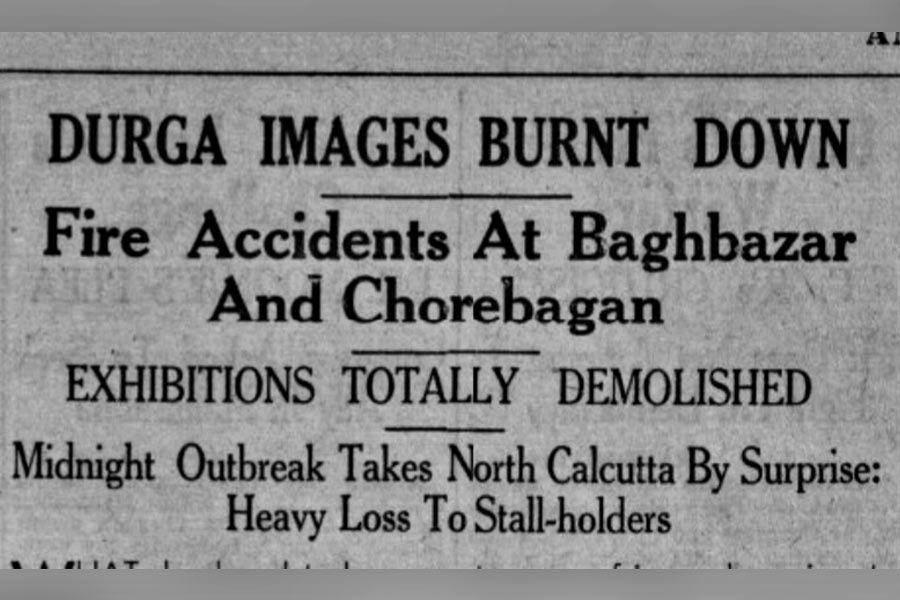
A cutting from Amrita Bazar Patrika
The report does not claim of any involvement of Gopeshwar Pal and Subhas Chandra Bose in combating the accident at the Baghbazar puja. Rather it mentions that “The Kumartuli image made by G Pal & Sons looks the replica of the past years though of course the image has gained in expressiveness”.
So, it is clear that a fire indeed occurred at Baghbazar Sarbojonin, and the making of a new idol overnight happened in 1940 —the incident had no connection with Kumartuli Sarbojonin Durgotsav.
In 1940, Subhas Chandra was not president of any puja committee. He was, then, passing through a crisis in his political career and was imprisoned in Presidency Jail. There, he organised a puja inside the jail for the inmates, as he did once in 1925 at Mandalaya jail of Burma. So, there is hardly any chance that Bose would make any request to anyone for a new idol.
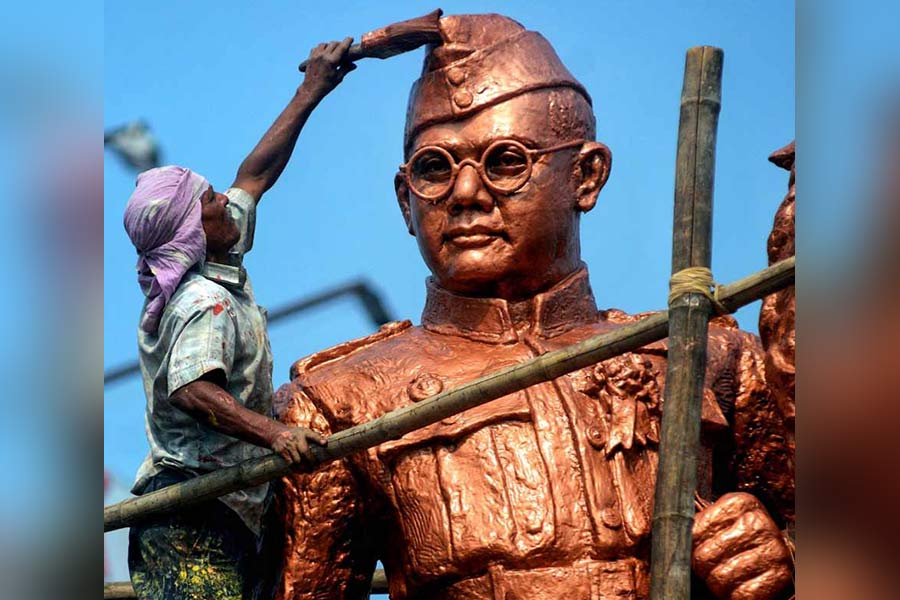
Bengalis love to include their beloved icon — Netaji — with anything that seems great
Bengalis are a legend-loving race, and they love to include their beloved icon — Netaji — with anything that seems great. Here, as well the confusing fact that Bose held presidencies in two nearby Puja committees in north Calcutta in same year, has given birth of confusion.
And, when confusion is backed with media propaganda, many baseless narratives are born – Sadly, the epochal work of Gopeshwar Pal has mingled with Netaji to concoct a wrong piece of information, and to flood social media with false narratives.
